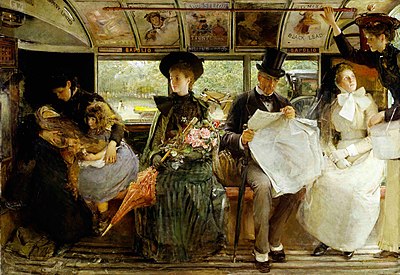Women in the Victorian era
| Victorian | |
|---|---|
| 1837–1901 | |
 | |
| Preceded by | Regency era |
| Followed by | Edwardian era |
| Monarch(s) | Queen Victoria |
The status of women in the Victorian era was often seen as an illustration of the striking discrepancy between the United Kingdom's national power and wealth. During the era symbolized by the reign of a female monarch, Queen Victoria, women did not have the right to vote,[1] sue,[2] or – if married – own property.[3][4] At the same time, women participated in the paid workforce in increasing numbers following the Industrial Revolution. Feminist ideas spread among the educated middle classes, discriminatory laws were repealed, and the women's suffrage movement gained momentum in the last years of the Victorian era.

Further Reading[change | change source]
- Goodwin, Harvey (1885). . London: Society for Promoting Christian Knowledge.
The Simple English Wiktionary has a definition for:
repealed, discriminatory, momentum, and discrepancy.
References[change | change source]
- ↑ Buckner, Phillip Alfred (2005). Rediscovering the British World. Calgary: University of Calgary Press.
- ↑ Wise, Sarah (2009). The Blackest Streets: The Life and Death of a Victorian Slum. London: Vintage Books. p. 112. ISBN 978-1-84413-331-4.
- ↑ Buckner, Phillip Alfred (2005). Rediscovering the British World. Calgary: Calgary University Press. p. 137.
- ↑ Kreps, Barbara Irene (Spring 2002). "The Paradox of Women: The Legal Position of Early Modern Wives and Thomas Dekker's The Honest Whore". ELH. 69 (1): 83–102. doi:10.1353/elh.2002.0007. S2CID 144628070.
